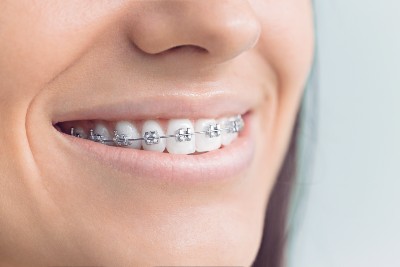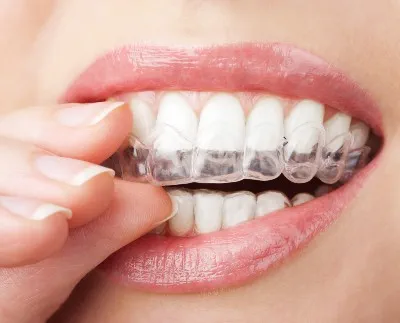Caring for your brace
About
Orthodontic treatment is a long-term solution for aligning crowded or crooked teeth. Whichever brace or aligners you have, it’s important to care for them properly to prevent breakage and any delay to your treatment. We’ve put together the following advice to support you in your journey.
Cleaning your braces
If you have Invisalign aligners, or any other type of removable brace, we recommend using a specific cleaning system as advised by your dentist. You can also brush aligners using a toothbrush and toothpaste, under lukewarm water. It’s important to never use hot water, which could warp the plastic. It’s always best to brush your teeth about 30 minutes after eating or drinking before putting your aligners back in, to avoid staining them.
For fixed braces, it’s important to brush over each bracket and wire, and angle the toothbrush up, to clean underneath them. Cleaning in between the teeth and brackets, known as interdental cleaning, is also really important. Your dental team will give you all the advice and demonstrations that you need.
Interested in teeth straightening?
Get in touch with your nearest Bupa practice. They can help you book an orthodontic consultation and answer any queries.
Eating and drinking with braces
If you have fixed braces, or a removable brace that’s worn while eating, you’ll need to keep a careful eye on your diet to avoid damaging the wires. It’s best to avoid sticky foods, such as toffee, caramel and lollies, that can break or loosen braces. Hard and crunchy foods can also cause damage, including apples, raw carrot, pizza crust, nuts, biscuits and celery.
You can still enjoy these foods in moderation, just break them into small pieces and try to chew them with your back teeth to avoid any breakages.
Some removable braces need to be removed for eating and drinking, for example, Invisalign and Inman aligners. Water is the only drink that’s recommended when you’re wearing aligners, as everything else can stain the appliance.
Whichever type of orthodontics you have, your teeth may be tender after starting treatment, after readjustments to your braces or when you receive a new set of aligners. If this occurs, try to cut up foods you would usually bite into, such as fruits, vegetables and sandwiches. At these times, it’s better to eat foods that need little or no chewing, which include soup, pasta dishes and low-sugar or natural yoghurts.

Spotting problems with your braces
If you think your braces or aligners may be damaged, you can feel them gently for any bent or loose parts. But don’t fiddle with your braces unnecessarily, as this can worsen existing damage or create new issues.
If you spot any issues, or experience any pain, it’s important to contact your dentist as soon as possible. If you have fixed braces, they’ll usually arrange an appointment to fix and readjust them. If you have aligners, your dentist may suggest ordering new ones, or wearing the next or previous set.
If you regularly damage your braces, this will lengthen your treatment time. So, it’s important to follow the advice from your dentist to keep your treatment time as short as possible.

Relieving orthodontic pain
Discomfort is normal in the first week of treatment, when braces are adjusted or you change aligners. You may experience sore gums and sore teeth, particularly when eating. These can be soothed with painkillers and by rinsing with salt water.
If you have fixed braces, you may find the brackets and wires rub against your cheeks and tongue. This can be prevented by applying orthodontic wax over the parts of the brace causing discomfort. You can usually get this from your dentist, or from your local pharmacy. You can also apply a local anaesthetic gel to any affected area to numb any pain.
If you have aligners, the edges may rub against your inner cheeks and gums at first. Generally, this is just where you’re getting used to the aligners in your mouth and it should ease with time. If this doesn’t ease, speak to your dentist for advice, as any uncomfortable edges can be smoothed down.
If you experience continued pain with braces or aligners, or have any concerns, it’s important to contact your dentist as soon as possible.

Brushing and flossing with braces
It’s important to keep your teeth healthy for your orthodontic treatment to be successful. This includes flossing or cleaning with interdental brushes daily and brushing your teeth for two minutes, at least twice a day, with a fluoride toothpaste. If you don’t clean your teeth regularly, food and plaque can linger to eventually cause gum disease and tooth decay. And in the later stages of tooth decay, you could even lose a tooth.
While removable aligners can be removed for brushing and flossing, caring for fixed braces requires some extra care. Make sure you brush along the gum line, using a 45-degree angle, as well as brushing below the brackets. To clean between the brackets, we recommend using an interdental brush. Flossing with braces can be difficult, but it’s important to persevere. Dental tape, waxed floss and floss threaders can be particularly helpful tools when you have braces, as opposed to traditional floss. Speak to your dentist for more advice.
Your dentist might also advise you see a hygienist throughout your treatment, to give you tailored oral health advice and make sure you’re cleaning properly.
Playing sport with braces
Wearing braces won't stop you from playing sports, as long as you take care to protect your smile.
If you have fixed braces, you can wear a specially-designed orthodontic mouthguard. This will protect your braces to ensure they don’t get damaged, particularly for contact sports like rugby.
Removable aligners typically need to be worn for around 20 hours a day, so you can usually remove your aligner while you’re playing sports. Some aligners are suitable to keep wearing – it will depend on the type of brace your dentist recommends.
If you’re concerned about sports and braces, speak to your dentist. They’ll be able to advise on which treatment best suits your lifestyle.

The importance of your diet
It’s important to eat a well-balanced diet, so your teeth remain healthy and strong throughout treatment. Eating too much sugar increases the risk of tooth decay, so it’s best to keep sugary foods and sweets to a minimum. And we advise avoiding fizzy and soft drinks – even diet ones. Although they contain low or no sugar, they’re still very acidic, which can erode the enamel on your teeth.
To help protect your teeth, we recommend eating three meals a day, instead of snacking. But if you do get hungry in-between meals, we recommend choosing healthy options, such as wholemeal bread, plain cheese, fruit and vegetables. And when you’re thirsty, plain milk or still water is best. Fruit juices should be kept to mealtimes only.
Follow-up appointments
Before you start treatment, your dentist will discuss what the journey will look like, including any check-up and review appointments. At the end of your treatment, your dentist will discuss a retainer to keep your teeth in their new position.
If you have any questions, or concerns at any stage, it’s important to get in touch with your dentist as soon as you can.
Learn more about orthodontics
If you have any questions about braces and how to care for them properly, get in touch with your local practice, who’ll be more than happy to help.

Find out more
All about crooked teeth
Did you know that crooked teeth can put you more at risk of several issues overtime, including gum disease, tooth decay and tooth fractures?
Learn more about braces
Considering straightening your smile? Find out how braces work, what to expect and the types of braces available.
^ We may record or monitor our calls.
Bupa Dental Care is a trading name of Oasis Dental Care Limited. Registered in England and Wales No: 00478127. Registered office: Bupa Dental Care, Vantage Office Park, Old Gloucester Road, Hambrook, Bristol, United Kingdom BS16 1GW.
Oasis Dental Care Limited has a number of trading names including Bupa Dental Care. Please see the list of our different trading names.


